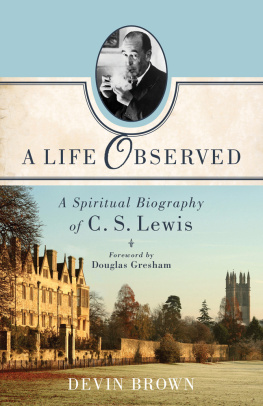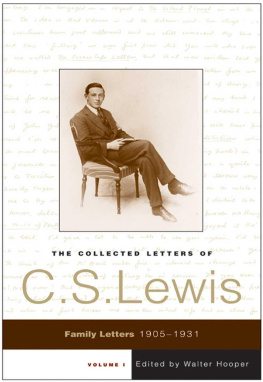
E ven while Roger Lancelyn Green and I were writing this biography we knew it would someday need revising. C.S. Lewis was a prolific letter-writer and, since the book was published in 1974, many new letters have come to light. Numerous reminiscences by former students and others have also been published since that time. Besides this, a new generation of Lewis readers was coming along, and we knew that, besides incorporating much new material into our book, certain adjustments in the portrayal of Lewis and his world would be needed.
It is a matter of great sadness to me that Roger and I were not able to work on this new edition of the biography together. Roger Lancelyn Green died on 8 October 1987, and I have had to revise it by myself. Even so, I do not think my old friend would find it a very different book from the one we wrote together. We expected further information to come to light about, among other things, the Inklings, Lewiss election to a chair at Cambridge, and his marriage to Joy Davidman, and this has meant the book has grown by two additional chapters. Still, while I have been the sole reviser, this new edition developed out of plans Roger Lancelyn Green and I made together, and it remains as much his book as mine. We were sorry our original publisher had an aversion to footnotes; I know Roger would be glad to see references to all published and unpublished writings given in the new edition.
C.S. Lewiss beloved brother, Warnie, died shortly before the first edition of the biography was published. If he were still alive I would thank him again for the help and encouragement he gave us. The extended treatment of the Inklings in this revised biography owes much to Brothers and Friends: The Diaries of Major Warren Hamilton Lewis, ed. Clyde S. Kilby and Marjorie Lamp Mead (1982). I am grateful, as well, to the C.S. Lewis Company for allowing me to quote so extensively from the unpublished letters and papers of C.S. Lewis.
Many others have helped with this new book. I owe particular thanks to my co-authors son, Richard Lancelyn Green, for sharing his fathers thoughts on C.S. Lewis and helping me in a hundred ways. Of what Lewis called unambiguous debts those to whom I owe the most are Dr Francis Warner, Professor Emrys Jones, Dr Barbara Everett, Douglas Gresham, Dr A.J. Reyes, Dr Jeremy Dyson, Professor James Como, Dr Judith Priestman of the Bodleian Library, and my copy-editor, Steve Gove. I am grateful to Michael Ward and Scott Johnson for helping with the proofs. Finally, while this biography continues to be dedicated to C.S. Lewis and W.H. Lewis Jack and Warnie I offer my share in the revised book to Roger Lancelyn Green.
WALTER HOOPER
T o write the biography of a man of genius as many-sided as C.S. Lewis is a daunting task, and it has not been undertaken lightly. His ideal biographer would have to be at once a Classical and English scholar, a theologian, a philosopher, an expert on fantasy, science fiction and childrens books and no one but Lewis himself possessed all these qualifications in sufficient degree.
The two of us who have collaborated in the present volume fall far short of his learning, even in our own subjects: Walter Hooper is a theologian who has read English; Roger Lancelyn Green is an English scholar who has written fantasy and childrens books both of us know and love the classical lands and have studied their literature; neither of us is a philosopher.
Why, then, are we undertaking this book? As early as May 1953 Lewis suggested to Roger Lancelyn Green that he should one day undertake his biography: when asked by his publisher Jocelyn Gibb of Geoffrey Bles Ltd to write a more formal autobiography than Surprised by Joy, Lewis replied: Oh, no, but when Im dead I suppose Roger will write my biography and Jock will publish it. And during the last six months of his life he was apologizing to Roger for giving Walter material which he might have thought was his special perquisite as chosen biographer.
Under these circumstances when we were approached by several of Lewiss closest friends, including Jock Gibb, and supported by Warren Lewis, it seemed our duty, as it was our pleasure, to accept the honour, however frightening.
Our particular qualifications were fairly evenly balanced. Green had attended Lewiss lectures, been his pupil for a B.Litt. course, and later became his friend at the time when the Narnian books were being written a friendship that grew closer with time and with shared interests and experiences, culminating in the visit to Greece in 1960; he had also written the Bodley Head Monograph on Lewis which its subject had read in manuscript and approved, though usually averse to books about himself or other living authors.
Walter Hoopers personal acquaintance with Lewis was shorter fewer months indeed than Greens years. He had already studied Lewiss works preparatory to writing the critical volume which did not materialize, and since Lewiss death had given much of his time to collecting and editing his miscellaneous and unpublished works, making collections of his letters or copies of them, and generally soaking himself in everything written by or about Lewis until he had become the leading authority on his life and works.
The material for any authorized biography of C.S. Lewis is immense, though singularly uneven. When the family home on the outskirts of Belfast was broken up after his fathers death in September 1929, Lewis found a gigantic mass of old letters, diaries and papers: his father seemed to have kept everything and destroyed nothing. He transported most of this to Oxford, and during the next few years his brother, Major Warren Lewis, selected and typed the larger portion, making a history of the family to the end of 1930. The Lewis Papers takes up eleven volumes of single-spaced typing averaging 300 pages to a volume. When the typescript was completed all the original manuscripts were destroyed.
This colossal monument of paper contains many hundreds of letters from C.S. Lewis to his father, his brother, his close friend Arthur Greeves, and a few other family connections; it also includes diaries, sometimes kept with great minuteness, covering many years. After 1929 Lewis wrote no more diaries.
Thus the basic material for the first chapters of the present book was so vast that it took many months to read and sift and many more to convert into a balanced narrative, and then cut and prune so as not to overweight this biography. Doubtless in time to come other books on C.S. Lewis will be written which will incorporate much of what we were forced to leave out: for we would like to stress that the present work is only a biography of C.S. Lewis; it was never intended to be the biography, a book which, if ever written, must still be well in the future when Lewis will have found his true level among writers and theologians.
Also, the material contained in the Lewis Papers covers the period about which Lewis had written most fully in Surprised by Joy: The Shape of My Early Life (1955) and many of the letters, with numerous extracts from the diaries, had been included by Warren Lewis in his volume of Letters of C.S. Lewis (1966), from neither of which did we wish to quote more than was necessary, or overlap except to present a rounded picture of our subject and the story of his life. The diaries and letters in the Lewis Papers, though of considerable interest, deal mainly with the simple, everyday facts of his life, and tell at great length of his adventures among books of his vast reading and of his own early literary attempts but surprisingly little of his inner life, his more personal experiences, or even of his spiritual pilgrimage: for almost all that we are likely to know of these we must turn to his published works, notably
Next page














